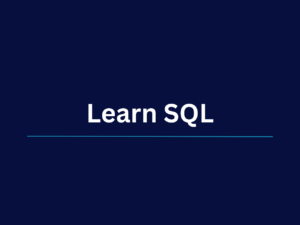The power of a database, with the simplicity of a spreadsheet – Airtable is the no-code collaboration platform trusted by thousands of organizations like Netflix and Shopify.
Learn from more than 7 hours of relevant instructional video content, with the only complete beginner to expert guide on Airtable. No coding or any expertise required!
Do you want to take your organization’s data to the next level? Do you want to have a single source of truth that your team relies on? Do you want to have one workspace for all of your solutions? Do you want to automate common workflows? Then harness the power of Airtable, a no-code browser-based data platform.
This course is the only comprehensive guide you’ll ever need to Airtable. It covers everything from Beginner topics like fields, table linkages, and views to more advanced topics like apps, automations, and workflow management. The course also takes you step-by-step and assumes you have no experience at all with Airtable.
The course is designed so you become an expert at Airtable. We do this by learn all the concepts in stages – beginner, intermediate, and then expert. We create an entire Airtable workspace from scratch. We also continuously update the course!
If you’re looking for something that will teach you how to create powerful business solutions with a single source of truth database, visualization, and automation platform using no-code from beginner to expert, then this is the course for you!
Airtable is rated as the #1 No-Code Workspace Tool. Airtable is trusted by over 200 leading organizations, like Netflix, TIME, Shopify, and Expedia. In March 2021, Airtable was given a $6 Billion valuation and shows absolutely no signs of stopping. Airtable also exists on the cloud, and gives you the full benefit of its scalability.
What is Airtable?
Airtable is a no-code intuitive browser-based platform to create single source of truth databases, that contains powerful apps, automations, and integrations, which are used to empower teams and improve efficiency, teamwork, and operations. Airtable gives you the power of a database and visualization software with the familiarity of an Excel spreadsheet. Organizations use Airtable to collaborate on projects.
What are the main features of Airtable? / Why should I learn Airtable?
- Powerful database: Airtable itself is a very powerful database – it contains rich fields to store files, photos, attachments, and holds complex fields like single selects and checkboxes. Airtable also allows you to link tables together, creating sophisticated linkages that work together to create powerful databases.
- Sophisticated views and forms: Airtable permits you to create views on your data, whether they would be in grid form, calendar, Kanban, timelines, or many more types. Airtable also has customizable forms used to share and input data.
- Robust visualizations: Airtable contains capabilities to produce dashboards with charts, that are automatically updated when your underlying data is modified.
- Extensible apps: Apps take your data in Airtable to a whole other level, whether in Pivot tables, Charts, Page Designers, or Summary calculators.
- Workflow automations: Airtable automates common workflows within your data – have a weekly digest that needs to be sent out? A sales plan that needs to be created for every new customer? Airtable will automate it for you.
- No-code platform: Airtable is a no-code platform that runs in your browser – you get the power of a database and visualization software without ever needing to write any code.
- Scalable: Since Airtable runs on the cloud, it can scale very well. Airtable is used by both small teams and large corporations (like Netflix), with full access to all features.
- Collaboration tools: Airtable is built with collaboration – it contains sophisticated sharing capabilities, commenting features, and permission settings.
Why take this course?
- Comprehensive guide: This is the only 100% start to finish, zero to hero, basic to advanced guide on Airtable. This course assumes you have zero experience with Airtable and develops you to an Airtable power user!
- Instructional with examples: The course is structured in a way to maximize your learning. We go through key structured learning blocks where we develop your Airtable toolkit. All examples used include the reference data, so you can follow along.
- Great resources: There are hours of content and resources in this course. There are more than 7 hours of video content available. You also have lifetime access to not only the videos, but to me as well through the Q&A feature. We also offer a 30 days money-back guarantee.
Course and Module Overview
- Introduction: learn about the features of Airtable and how to succeed in the course
- Beginner – Set up: create an Airtable account and learn the terminology
- Beginner – Fundamentals: learn how to load data, edit records, and look at version history
- Beginner – Data: learn how to manipulate data using filters, sorts, etc. and how to add new complex columns
- Beginner – Load: learn how to load data and create data from scratch
- Beginner – Views: learn how to create views, calendars, galleries, Kanbans, and more
- Intermediate – Forms: learn how to create forms used to update tables and add data
- Intermediate – Relationships: learn how to connect tables with each other and create linked records
- Intermediate – Collaborate: learn about the sharing and permissions functionality
- Intermediate – Apps: learn how to use Pivot Tables, Charts, Page Designers, and other Airtable apps
- Intermediate – Dashboards: learn how to combine apps to create Airtable dashboards
- Expert – Scripts: learn how to deploy Airtable scripts like dedupe and batch update
- Expert – Automations: learn how to automate common workflows in Airtable
- Expert – Integrations: learn how to integrate Airtable with other 3rd party applications
- Conclusion: learn about next steps, and obtain the certificate
We’re looking forward to having you in the course and hope you earn the certificate. Please let me to know if you have any questions!
Music: bensound







